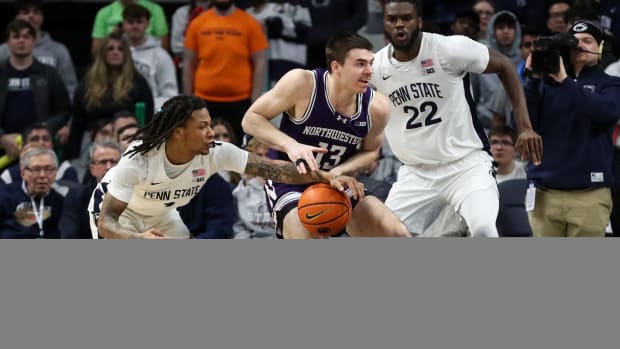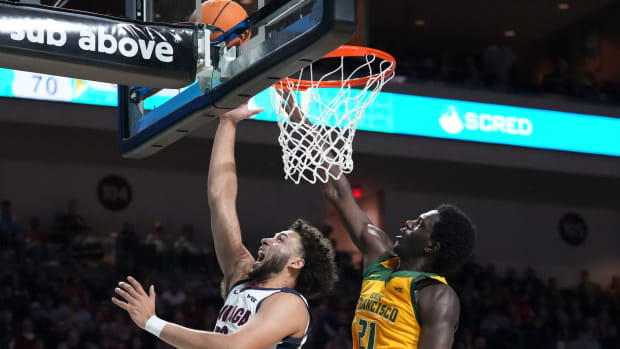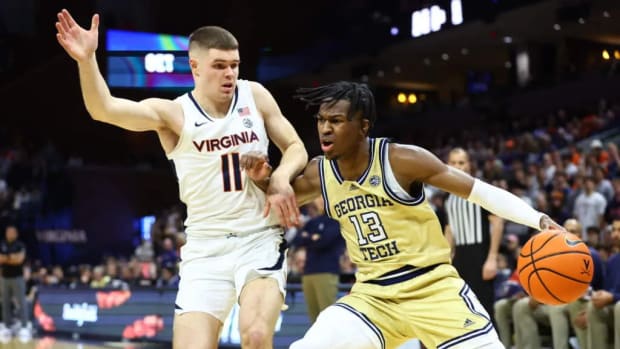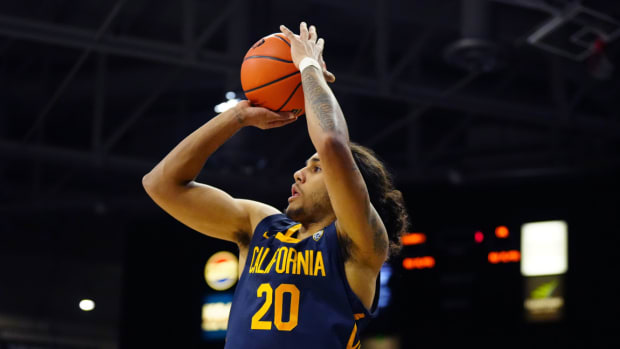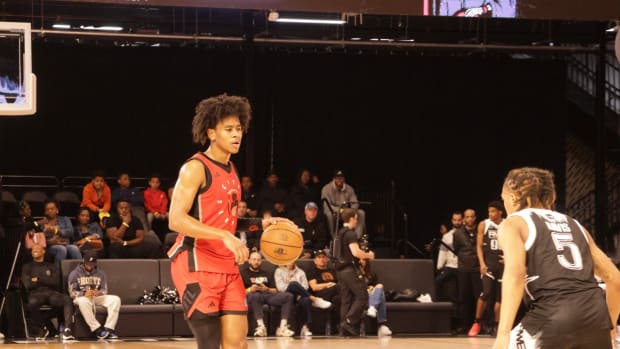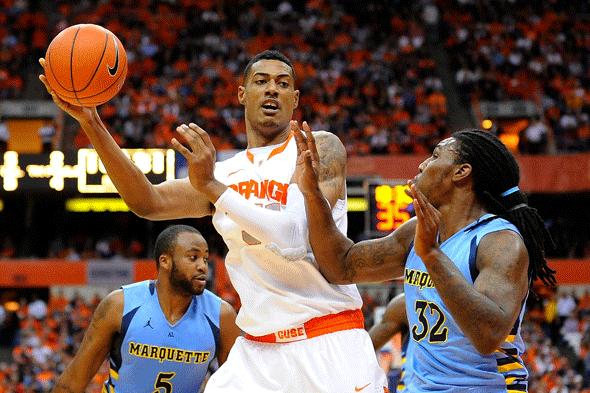
No Fab, No Future For Syracuse?
Syracuse's Fab Melo will not play in the NCAAs due to an eligibility issue. (Rich Barnes/Icon SMI)
The news that rocked bracketland on Tuesday afternoon: Syracuse's 7-foot center, Fab Melo, will miss the NCAA tournament due to academic eligibility issues, according to reports. If you can still edit your online pool sheet that had the Orange in the Final Four, you'd be wise to do so. For a guy with a pedestrian traditional stat line -- 7.8 points and 5.8 rebounds -- Melo has a mammoth impact on Syracuse's zone defense, and it lacks a quality backup at his position. (To give you an idea of how enamored coach Jim Boeheim is with the Orange's No. 2 center, Baye Keita, he got off the bench for a grand total of one minute in their two Big East tournament games.)
Losing Melo at this juncture isn't exactly a devastating blow on the level of Cincinnati losing Kenyon Martin to a broken leg in the quarterfinals of the 2000 Conference USA tournament. That cost the Bearcats a No. 1 seed -- a fate that, who knows, might have befallen Syracuse had it known (or revealed) Melo's ineligibility before Selection Sunday. I would argue, though, that losing Melo will hurt the Orange far more than the injury that robbed them of their center for the 2010 NCAA tournament, when they were also a No. 1 seed.
Arinze Onuaku suffered an ugly quadriceps injury in the 2010 Big East tournament and missed the big dance, but Syracuse also didn't reveal his tournament status until after the brackets were announced, and kept its No. 1 seed. It lost to Butler in the Sweet 16, but remained competitive because 6-9 junior Rick Jackson -- who went on to be the team's best frontcourt player the following year -- was able to slide into the middle in relief. The Orange have no Jackson in 2012.
In February, when we published an exhaustive, defensive-charting study of every possession of 15 Syracuse games on SI.com, Melo was the star. I called him "simultaneously the Orange's most obvious defensive force (by blocking 2.93 shots per game) and its secret weapon (by taking charges and creating turnovers)." He had the best individual defensive rating of any of Syracuse's big men. He engaged in the highest percentage of possessions (26.1), allowed the lowest field-goal percentage (29.1), and his forced-turnover rate, because he led the team in charges by a significant margin, was nearly as good as steal-master Dion Waiters'. Traditional box scores didn't come close to measuring the massive impact that Melo had on the Orange's defense.
Syracuse's team defensive chart from that story, which included its four big non-conference games (Virginia Tech, Stanford, NC State and Florida) and first 11 Big East games, looked like this:
(I would love to update this on the fly, but charting the rest of the season would take 12+ hours, and this post is serving as a quick react to the Melo bombshell. I believe these 15-game numbers are representative of the Orange's overall defensive profile, though.)
In a section called "Understanding the Melo Effect," I wrote:
Melo does not have the Orange's lowest DRating (that belongs to Waiters), but it's clear that Melo has the biggest impact. His engagement rate, or DPoss%, of 26.1 is the highest on the team, and the fact that he's able to maintain a strong DRating (86.5) while impacting so many plays is impressive. Syracuse's entire 2-3 seems to take its cues from Melo. "The most important position in the zone is the center," assistant coach Mike Hopkins said. "Fab protects the paint ... he lets us be more aggressive on the perimeter, and he's the eyes for the whole defense, talking and directing everyone else."
I made this graphic to visualize how defensive possessions are distributed across Syracuse's 2-3 zone alignment -- basically, how often a possession is ended (in a good or bad way) by each of the various defenders. As you can see, Fab Melo was incredibly important:
(The sum of the percentages in the chart is closer to 75 than 100 because in any given game, a sizable chunk of possessions are logged as "team." Those are the unforced misses and turnovers, or the unblame-able transition/scramble baskets allowed, and the impact of those possessions is spread across everyone who was on the floor.)
And when Fab was compared to his potential replacements at center, the drop-off was clear. As I wrote in February, "While his primary backup at the center spot, sophomore Baye Moussa Keita, has a similar rate of success challenging shots (opponents shoot 30.4 percent against Keita and 29.1 percent against Melo), Keita takes fewer charges and fouls almost twice as often. Keita creates a team-high 64.0 free throws per 100 field-goal attempts faced (DFTA/DFGA, in the chart) as opposed to 37.7 for Melo. When the Fighting Irish upset Syracuse on Jan. 21 in South Bend [with Melo out during his previous academic suspension], Keita created eight free throws that resulted in six points."



